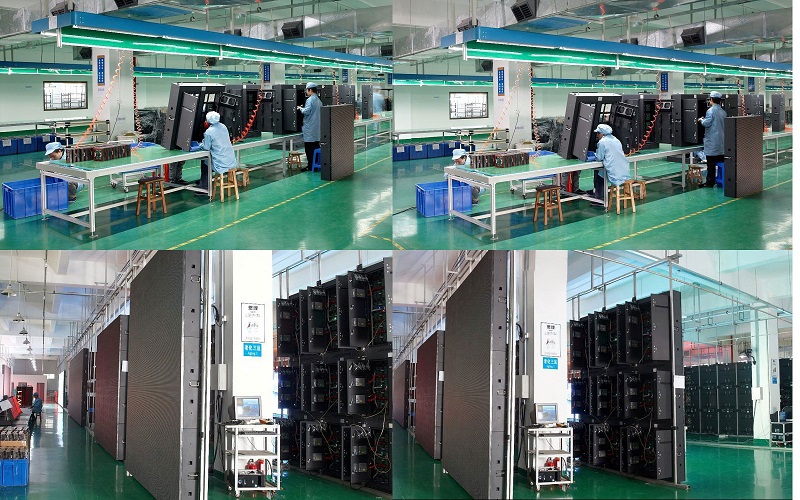CUSTOM SUPPORT & SALE
CUSTOM SUPPORT & SALE
LED display Driving Scan Way, the ratio of the number of rows lit at the same time and the number of rows in the entire area within a certain display area. It is well known that the common drive modes of led display screen are static scan and dynamic scan. Static scan is divided into static real pixels and static virtual pixels. Dynamic scan is also divided into dynamic real pixels and dynamic virtual pixels.

Static and dynamic are two different ways of driving the LED display.
If the driving circuit lights up every pixel of the LED lights on the screen each time, it is called static drive or static scan. If each lighted row or column is discontinuous, for example, there are 1, 2, 3, 4, 5, 6, 7, 8, 9, 10... rows of pixels, lit number one and number nine rows at a time, Then in a very short period of time, number 1 row and number 9 row went off, number 2 row and number 10 row lighted up, and in a very short time, replaced with 3 and 11 lights up, that is 1/8 sweep; if 1 and 5 were on, it was After a short period of time, it is replaced by number 2 and number 6 line, and recursively, that is, 1/4 sweep; if number 1 and number 3 line are on, the instantaneous number 2 and number 4 line are on, which is 1/2 sweep. Because people have visual persistence, they can't see that the lights are extinguished, and they always look bright.
Advantages / Disadvantages of full color LED display screen dynamic driving method :
The advantage is that the display driving circuit is simple, two ICs can drive eight 10" or less LEDs, and the cost is lower. Various sizes of LEDs can be directly connected with the main control board, the drive board and the expansion board, or even without the PCB board. Low power consumption, time-sharing display, power consumption is only 1/5 of the static display.
The disadvantage is that there are many connections between the LED and the driving board (a total of 8+LEDs). When the number of digits is too large, the connection and maintenance are inconvenient.
Advantages / Disadvantages of full color LED display screen static driving method :
The advantage is that the connection between the LED display components is very simple. Only 5-6 wires are needed to connect all the LEDs in series. It is easy to debug and overhaul. The display has good brightness, and it can drive 2m or less LEDs with suitable driving components, which is suitable for making large-scale outdoor digital screens.
The disadvantage is that each LED requires 1-2 driving ICs and the display module PCB board needs to be manufactured. The power consumption is slightly larger (5 times that of the scan drive). The cost is slightly higher (on average, the cost of each part of the display driving is 0.4 to 1 USD higher than that of the scan driving).
First, the LED display scan mode classification:
1. Static scan: Static scan is to implement "point-to-point" control from the output of the driving IC to the pixel. Static scan does not require a control circuit. The cost is higher than dynamic scan, but the display effect is good, the stability is good, and the brightness is lost.
2. Dynamic scan: Dynamic scan is to implement "point-to-column" control from the output of the driving IC to the pixels. The dynamic scan requires a control circuit. The cost is lower than the static scan, but the display effect is poor and the brightness loss is large. .
Second, according to the environment:
Indoor single and double color LED display is generally 1/16 scan, indoor full color LED display is generally 1/8 scan, outdoor single and double color LED display is generally 1/4 scan, outdoor full color LED displau is generally static scan.
Third, according to the model:
1, indoor full-color LED display scan method: P4, P5 constant current 1/16, P6, P7.62 constant current 1/8.
2, outdoor full-color LED display scan method: P10, P12 for constant current 1/2, 1/4, P16, P20, P25 is static.
3, single and double-color LED display scan mode is mainly constant current 1/4, constant current 1/8 sweep, constant current 1/16 sweep.
Fourth, LED display scan mode:
Static: also known as 1/1 scan. static scan LED display with high brightness, is suitable for outdoor use. Its control method is to power a single pixel of a single color (usually a LED lamp). In this way, each pixel has enough drive current and the brightness is correspondingly higher.
1/2 Scan: Under the same conditions as other conditions, the 1/2 scan LED display has lower brightness than static and is suitable for outdoor and semi-outdoor applications. Its control method is equivalent to the current that is originally supplied to a single lamp and also provides two LED lamps. So it will decrease brightness. Of course, when two LED lamp currents are supplied at the same time, it is not the average distribution current, but the current is continuously scanned between the two LEDs. The scan frequency reaches 100 times per second, that is, the current is within 1/100 second. One of the LEDs is supplied with another LED in the next 1/100 second. In fact, these two LEDs are constantly on and off, but the visual persistence effect of the human eye does not allow us to perceive them to be constantly on and off. As long as the scan frequency reaches more than 64 times per second, the human eye cannot distinguish between them. .
1/4-scan: Under the same conditions, the 1/4-scan display has half the brightness of the 1/2-scan display and is suitable for semi-outdoor and indoor applications. The control method is increased from two LEDs of 1/2 to four LEDs. Current scans between 4 LEDs.
1/8 scan, 1/16 scan: These are belong to lower brightness driving method and are generally only used indoors.
Contact us for LED display screen for your requirement now.


Contact: Lee
Phone: +86-132-6566-7728
E-mail: info@colorlitled.com
Add: Tangtou Industrial Park,Shiyan,Baoan,Shenzhen